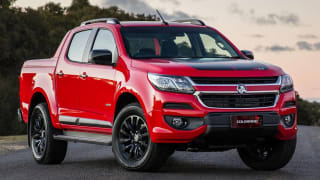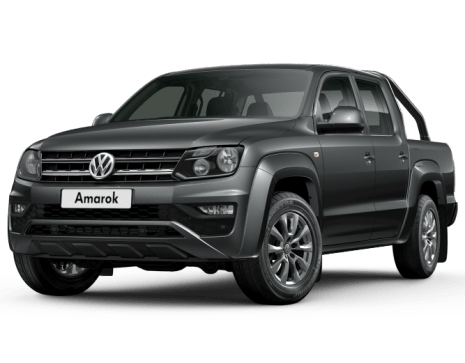
Holden Colorado Z71 2016 review
Bill McKinnon road tests and reviews the Holden Colorado Z71 with specs, fuel consumption and verdict.
Browse over 9,000 car reviews
There's no doubt Aussies love their dual cab utes. And the Volkswagen Amarok shook up the establishment with its Euro styled and Euro feeling four-cylinder diesel a few years ago.
But Aussies also love performance, power and towing ability, so Volkswagen has updated the Amarok with the engine from a Porsche Cayenne diesel. The drivetrain upgrade has certainly done the trick, with double the power and more than triple the torque. But has it made the Amarok a better truck?
The Amarok is a no-nonsense rig. With its flared guards, straight lines, bluff sides and large rims, it cuts an imposing figure that is a big step away from the more angular and stylised lines of competitors like the Toyota HiLux, Ford Ranger, and Mitsubishi Triton.

Adding to the street tough look is the fact that the tyres are essentially road going items as opposed to chunky off road units. A uniquely styled sports bar adorns the rear end and is neatly designed to avoid intrusion into the load space.
Likewise, a (sprayed on) bed liner is a welcome addition, because it doesn't compromise valuable load space like a plastic, drop-in tub liner.
The interior is not much different to base level Amaroks, while the commercial origins aren’t hard to spot, with exposed bulkhead seatbelt bolts at the base of the B-pillars, and large areas of hard plastic clearly evident.
If you’ve seen the inside of a base model Amarok, then you’ll be familiar with the layout and controls in this $70,000 version of essentially the same thing.
The Amarok 550’s ride is also worthy of considerable praise. It doesn't feel at all like a dual cab ute
Sure, there are a few more bells and whistles to be had in this top-spec variant, including leather trim, a colour touchscreen multimedia system, excellent front seats that feature heating and extra under-thigh length, as well as in cabin switchable four-wheel drive and an off-road mode button
It's worth mentioning those front seats again; they are among the most comfortable ever fitted to a regular dual cab ute. The Amarok cabin is wider than competitors like the Ford Ranger and Toyota HiLux as well, giving the cabin an airy, comfortable, and broad feel.
There are a few nice touches, including a padded rest for the left leg, a pair of 12-volt ports up front and one in the rear, as well as a USB port. A multimedia system features Bluetooth streaming, satellite navigation, and digital radio, as well as Apple CarPlay and Android Auto.
There are sufficient hidey-holes around the cabin for items like mobile phones. The cup holders in the front are lifted directly from the commercial version and are a bit low and small for taller cups. There are bottle holders in all four doors, though, and an additional pair of cup holders for rear seaters down near the floor.
Speaking of the rear seats, while there is plenty of room up front for driver and passenger, the rear seat area in the Amarok is quite small. With a taller driver in position, the back seat becomes very cramped, especially for leg and toe room.
Headroom, too, is compromised by the fact that the seat base is mounted quite high. It is broad across the back so three kids will fit easily. But the seat backs are also quite upright, given the shape of the cabin. And thanks to its commercial origins there are no air vents for rear seat passengers.
The aforementioned 3.0-litre turbo diesel V6 makes 165kw at 3000rpm, and 550Nm between 1500-2750rpm.
Those power and torque figures are already solid for a ute, and even more impressive when overboost is factored in. Available from 70 per cent throttle in third or fourth gear, it adds 15kW for a total of 180kW and 30 extra Nm for a total of 580Nm.
The eight-speed traditional automatic transmission has been retained.
The Amarok’s biggest party trick is that V6 engine with 550Nm of torque on call. What's not as immediately apparent is the fact that it's actually a diesel at all. The engine, lifted from the Porsche Cayenne and Audi Q7, is astonishingly smooth, incredibly refined and very high on performance.
In fact, it takes a period of adjustment to get used to the Amarok’s eager throttle response in the early part of the pedal's travel. It occasionally feels like Volkswagen is trying to prove a point with the extra toey accelerator, but with a few kilometres under the wheels it does become easier and more manageable.
The eight-speed gearbox is a perfect match for the larger performance engine with seamless changes through the range, and it can also be operated by steering wheel-mounted paddles. There is a start/stop system fitted to the top-spec Amarok, but it's more annoying than helpful with a huge shudder on start up and on shut down.
The Amarok 550’s ride is also worthy of considerable praise. It doesn't feel at all like a dual cab ute, rather a higher spec SUV. However, there's some wander with the steering on centre, which can make long highway journeys tiresome, given the amount of wheel work needed to keep this truck on the straight and narrow.
Noise, vibration and harshness are very well suppressed, again thanks to the road spec tyres, although there's a bit of wind rustle around the large – again, commercially sourced - mirrors. The top-spec Amarok also benefits from having disc brakes on each corner, and the higher quality tyre helps with grip.
Having said that, the tyres are essentially unsuitable for any kind of off-road work. Tyre pressures can be lowered if you are traversing a sandy beach or gravel tracks, and the four-wheel drive systems work perfectly well with excellent hill decent control and confident all wheel performance over moderate to rough tracks.
The compromise is the tyre package though; you're not going to get too far off road with this city-slicker rubber.
And while we didn't get a chance to tow, the Amarok can haul up to 3000kg in Australian trim. This has been limited via a Volkswagen Australia-imposed hot weather tune, with overseas cars able to tow 3500kg.
The Amarok 550 V6 Ultimate is certainly not cheap at $67,990 before on-road costs… and for the money we wonder if it's actually good value.
On the surface there are a few glaring omissions in the Amarok. For example, an almost complete lack of safety assist tech like radar cruise control, lane departure warning, auto emergency braking, or even trailer sway control.
It's a bit of a puzzle given how readily available these systems are in the Volkswagen world. Rivals like Ford and Toyota understand the need to fit such safety equipment, if for no other reason than to achieve a five-star ANCAP rating, often required by Australian businesses, like mining companies and other primary industries.
The Amarok does have a five-star ANCAP rating but this was awarded in 2011. If re-tested in the current environment, it's unlikely to score anything like five stars.
And while it may be comparing apples to oranges, a glance across other vehicles in the Volkswagen family reveal there are other load carriers offering on-par performance and significantly better value than the Amarok.
Take for example, Volkswagen's own Passat 206TSI wagon. For significantly less money it offers a great deal more standard kit and still has the ability to tow and carry luggage.
Granted, it's not a ute, which is of course a particular kind of body style that some people need and want.
Glancing down the Amarok range, the equivalent Ultimate in the 2.0-litre four-cylinder diesel form is priced at $63,990 before on-roads, making the 550 a significant jump in price for the privilege of a (very good) V6 diesel engine.
The Amarok is claimed to use 7.8 litres per 100km on the combined fuel economy cycle. We recorded 9.4L/100km after 650km of testing.
It has an 80-litre fuel tank, giving it a theoretical range of 1000km.
The Amarok has a three-year unlimited kilometre warranty, while services are scheduled for every 15,000km or12 months.
Fixed service costs are $470, $663, $557, $824 and $470 respectively for the first five, totalling $2984.
Besides front airbags, ABS brakes, stability and traction control and a rear view camera, the Amarok lacks every other form of modern electronic safety aid that families come to expect in an expensive vehicle.
It currently holds a maximum five-star ANCAP rating, from 2011.
The Amarok V6 has received a rapturous reception with orders flooding in despite its higher cost. In fact, during our time with the car we had several people approach to ask for our thoughts on it and sneak a closer look.
The engine and drivetrain package is a good fit for the car, and it handles it well. The price of entry, though, is a significant barrier, especially in light of the lack of fundamental safety elements like rear curtain airbags for backseat passengers, radar cruise and auto emergency braking.
Click here for more 2017 Volkswagen Amarok pricing and spec info.
| Vehicle | Specs | Price* | |
|---|---|---|---|
| TDI400 (4X4) | 2.0L, Diesel, 8 SP AUTO | $19,360 – 24,530 | 2017 Volkswagen Amarok 2017 TDI400 (4X4) Pricing and Specs |
| TDI340 (4X2) | 2.0L, Diesel, 6 SP MAN | $20,350 – 25,740 | 2017 Volkswagen Amarok 2017 TDI340 (4X2) Pricing and Specs |
| TDI420 Core Edition (4x4) | 2.0L, Diesel, 8 SP AUTO | $20,240 – 25,630 | 2017 Volkswagen Amarok 2017 TDI420 Core Edition (4x4) Pricing and Specs |
| TDI420 (4X2) | 2.0L, Diesel, 8 SP AUTO | $23,100 – 28,490 | 2017 Volkswagen Amarok 2017 TDI420 (4X2) Pricing and Specs |
$15,800
Lowest price, based on 167 car listings in the last 6 months